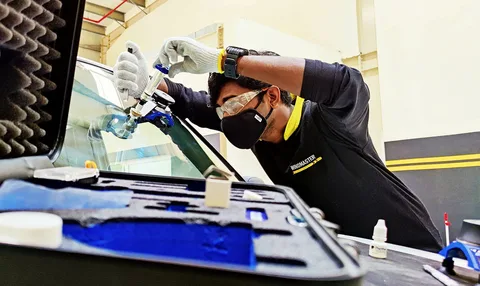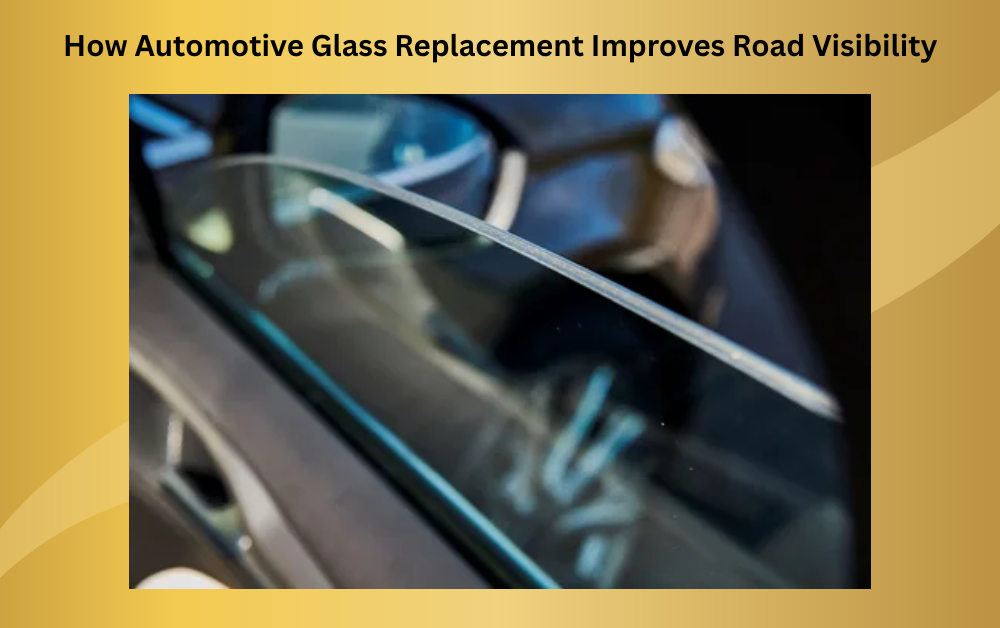When you think about car safety, your mind might go straight to airbags, seatbelts, or brakes. But there's one part of your vehicle that is just as important for your safety — your automotive glass. It might seem like just a clear window between you and the road, but your car's glass plays a huge role in how well you can see and how safely you can drive.
Over time, cracks, chips, scratches, or fogging can affect how light passes through the glass and reduce visibility, especially during bad weather or night driving. That's why timely automotive glass replacement is not just a repair task — it's a vital part of keeping you safe and maintaining your car's performance.
In this easy-to-understand guide, let's explore how automotive glass works, why clear visibility is so important, and how replacing your glass at the right time can make a big difference in your driving safety.
Understanding Automotive Glass
Automotive glass refers to all the glass parts installed in your car — the windshield, side windows, rear window, and sometimes even roof panels in modern cars. Unlike ordinary glass, automotive glass is designed with safety and strength in mind. It can handle pressure, protect you during accidents, and provide clear vision in different conditions.
There are two main types of glass used in vehicles: laminated glass and tempered glass .
Laminated Glass – Your Protective Shield
Laminated glass is mostly used in the windshield. It’s made by bonding two layers of glass with a thin layer of plastic in between. This structure helps it stay together even when it’s hit hard. So, if your windshield cracks, it won’t shatter into dangerous pieces — it holds together, preventing injury and maintaining your visibility until you get it fixed.
Tempered Glass – Strength with Safety
Tempered glass is used in the side and rear windows. It’s heated and cooled in a special way to make it much stronger than ordinary glass. When it breaks, it shatters into small round pieces instead of sharp shards, reducing the risk of injury.
The Role of Automotive Glass in Visibility and Safety
Your automotive glass is much more than a protective barrier. It plays a key role in your ability to see the road clearly and react quickly to what’s happening around you.
Providing a Clear View of the Road
The main purpose of automotive glass is to let you see the road, traffic, and surroundings clearly. A clean and undamaged windshield ensures that light passes through evenly, without distortion or glare.
Supporting the Vehicle’s Structure
Your windshield is an important structural part of your car. It helps maintain the shape and strength of the cabin. A damaged or weak windshield can vibrate, distort your view, or even collapse in an accident, making it harder to see or stay protected.
Working with Safety Systems
Modern cars have advanced systems like rain sensors, lane assist cameras, and automatic braking. These technologies rely on a clear and properly fitted windshield to work correctly. If the glass is cracked or installed poorly, these features might not function as intended, putting you at risk.
How Damage Affects Road Visibility
Even small cracks or scratches can have a big impact on visibility. Here’s how different types of damage affect your driving experience:
Cracks and Chips
A crack might look small at first, but it can spread across your windshield due to vibrations or temperature changes. These cracks scatter light and create glare, especially at night when facing oncoming headlights.
Scratches and Hazing
Over time, dust, wiper blades, and harsh cleaning tools can cause fine scratches on your glass. These scratches distort light and reduce clarity, making it harder to see during sunrise, sunset, or rain.
Fogging or Moisture
Old or poorly sealed glass can allow moisture between layers or around the edges. This fogging reduces transparency and can be distracting while driving.
Tinted or Dirty Glass
Too much tint or unclean glass can block natural light and reduce visibility, especially at night. Always keep your glass clean and use quality cleaning products.
Why Replacing Damaged Glass Is Better Than Repairing It Sometimes
Many people think repairing a chip or crack is always enough, but that’s not always true.
When Repair Works
If the chip is small and not in the driver’s line of sight, a professional repair can restore the strength and clarity of your glass.
When Replacement Is Needed
If the crack is large, deep, or blocking your vision, replacement is the safer option. Damaged glass cannot provide the same clarity or structural support. Even after repair, the optical quality may still be affected.
Replacing the glass ensures you get a fresh, clean surface that offers full visibility and safety.
The Process of Automotive Glass Replacement
Replacing automotive glass might sound complicated, but professionals make it quick and efficient. Here’s how it’s usually done:
-
Inspection – The technician examines the damage to decide if replacement is necessary.
-
Removal – The old glass and seal are carefully removed without damaging the frame.
-
Preparation – The frame is cleaned, and new adhesive is applied to ensure a perfect seal.
-
Installation – The new glass is carefully placed and aligned.
-
Curing – The adhesive is left to cure properly before the car is driven again.
The entire process can take between 1 to 3 hours, depending on the type of glass and vehicle.
How New Automotive Glass Improves Visibility
Once you get your automotive glass replaced, you’ll notice an instant difference in how clearly you can see. Here’s why:
Better Clarity
New glass is free of cracks, scratches, and haze. It allows natural light to pass evenly, reducing glare and improving visual comfort.
No Light Distortion
Old glass with scratches can bend light, creating glare or reflections that disturb your focus. Replaced glass eliminates these distortions, helping you drive comfortably in all lighting conditions.
Enhanced Night Visibility
Night driving becomes much safer because there are no reflections from cracks or chips. You can easily spot objects, road lines, and traffic signs without distractions.
Improved Response Time
When visibility is clear, you can react faster to sudden obstacles or changes in traffic, reducing the chance of accidents.
Additional Benefits of Replacing Automotive Glass
Restores Structural Strength
A new windshield restores the original strength of your vehicle’s frame. This helps protect you during accidents or rollovers.
Supports Modern Features
Many modern vehicles have sensors, cameras, or heads-up displays attached to the glass. New glass ensures these features work properly and accurately.
Enhances Comfort and Looks
A new, spotless windshield not only looks great but also keeps out noise and dust, making your drive smoother and more enjoyable.
Tips to Maintain Clear Visibility After Glass Replacement
Once you’ve replaced your automotive glass, following proper care tips can help you maintain its clarity for years.
Avoid Driving Immediately
Allow the adhesive to cure for at least a few hours after installation. Driving too soon can affect the seal.
Clean Regularly
Use a microfiber cloth and a non-ammonia glass cleaner to clean your windshield and windows. Avoid using harsh chemicals or dry wipes.
Replace Wipers Frequently
Old or hard wiper blades can scratch your new glass. Replace them every 6–12 months for best performance.
Park in Shade
Sunlight and heat can damage your glass and its seal over time. Parking in the shade helps protect it.
Keep a Safe Distance While Driving
Stones or debris from other vehicles can easily crack your glass. Maintain a safe distance to prevent damage.
Common Myths About Automotive Glass Replacement
There are many misconceptions about replacing automotive glass. Let's clear up a few of them.
“Small Cracks Are No Big Deal.”
Even a small crack can weaken your windshield and spread over time. It's best to fix or replace it early.
“DIY Kits Work Just as Well.”
Home repair kits may temporarily hide cracks, but they can't restore full strength or clarity. Professional services are safer and more reliable.
“Replacement Is Too Expensive.”
Many insurance policies cover automotive glass repair and replacement. Considering safety and visibility, it's a worthwhile investment.
Choosing the Right Automotive Glass Service
When selecting a service provider, look for:
-
Certified Technicians – Ensure they are trained and experienced.
-
High-Quality Materials – Always use glass that meets safety standards.
-
Warranty Coverage – A good company will offer a warranty on both materials and installation.
-
Customer Reviews – Check reviews and recommendations for trusted service.
A professional installation guarantees long-lasting results and peace of mind.
The Connection Between Clear Vision and Safe Driving
Driving is all about visibility. Your ability to see clearly and make quick decisions depends heavily on your windshield and windows. Replacing damaged glass is like giving your eyes a clear lens — it removes distractions, glare, and distortion.
A well-maintained and damage-free windshield ensures that you can:
-
Spot obstacles faster
-
Judge distances correctly
-
Drive confidently in different weather conditions
When your vision is clear, your reaction time improves, and your safety on the road increases significantly.
The Future of Automotive Glass
The automotive industry is constantly evolving, and so is glass technology. Some upcoming features include:
-
Heated Windshields that remove fog and ice automatically.
-
Heads-Up Displays (HUDs) that project navigation and safety alerts directly on the glass.
-
Solar-Control Glass that keeps the car cool by blocking heat and UV rays.
-
Smart Glass that can adjust transparency based on lighting.
Replacing your glass with modern, high-quality options can make your driving experience more comfortable and safer.
Final Thoughts
Your automotive glass does more than just let you see outside — it protects you, supports your vehicle's structure, and plays a vital role in your driving safety. Over time, even small cracks or scratches can reduce visibility, cause distractions, and increase accident risks.
Replacing damaged automotive glass restores perfect visibility, improves safety, and enhances the overall driving experience. Whether it's the windshield, side windows, or rear glass, timely replacement keeps your car looking great and performing at its best.
So next time you notice a chip or crack, don't ignore it — see it as an opportunity to make your ride safer and clearer. After all, a clear view means a safer road ahead.
For more insightful articles related to this topic, feel free to visit : turkhand.org



